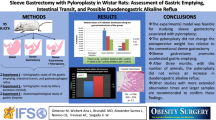Abstract
Purpose. The aim of this study is to investigate a pylorus- and vagus-nerve-preserving partial gastrectomy to discover any correlation to a reduced carcinoma occurrence from residual gastric mucosa.
Methods. Wistar rats underwent a distal partial gastrectomy (Group D), a pylorus-preserving partial gastrectomy (Group P), or a simple laparotomy (as a control) (Group C) while some also underwent an additional truncal vagotomy (Groups DV, PV, and CV). Continuous per oral administration of N-methyl-N′-nitro-N-nitrosoguanidine (MNNG) was given every day for 8 weeks before operation. At 3, 6, and 12 months after surgery, the animals in each group were administered an intraperitoneal injection of bromodeoxyuridine (BrdU). At 1 h after injection, the animal was killed, and the residual stomach removed.
Results. The histopathological findings showed no intestinal metaplasia and no gastric cancer in any group. No abnormality in the gastric mucosa was found in either Group C or Group CV. However, anastomotic ulcers, cystic glands, and submucosal gland formation were found significantly more in Groups P and in PV than in either Groups D or DV (each P < 0.05). Atypical glands were found in only one rat in each of Groups D and DV, and gastritis cystica polyposa (GCP) was found in only one rat in Group DV. All of these findings occurred in the fundic gland mucosa on the oral side of the anastomosis. The BrdU labeling index in this fundic gland mucosa was significantly higher in Groups D and DV than that in Groups C and CV, at 3, 6, and 12 months postoperatively (P < 0.05). The pH of the gastric juice was higher in all those groups that underwent vagotomy, with a significant difference only between Groups DV and C (P < 0.05). The concentration of bile acids contained in the gastric juice (μM/l) was significantly lower in Groups P and PV than that in Groups D or DV (each P < 0.05).
Conclusion. The preservation of the pylorus was considered to be a useful surgical method to prevent the retrograde reflux of the duodenal juice into the residual stomach, and also reduced the proliferative activity of the residual gastric mucosa on the oral side of the anastomosis.
Similar content being viewed by others
Author information
Authors and Affiliations
Additional information
Received: February 19, 2001 / Accepted: September 11, 2001
Rights and permissions
About this article
Cite this article
Takamiya, H., Koufuji, K. & Shirouzu, K. The Influence of Pylorus-Preserving Partial Gastrectomy on Carcinogenesis of Residual Gastric Mucosa in the Rat. Surg Today 32, 134–141 (2002). https://doi.org/10.1007/s005950200006
Issue Date:
DOI: https://doi.org/10.1007/s005950200006




